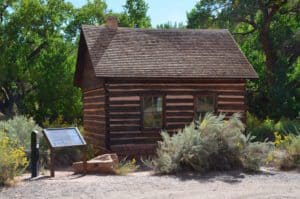Last updated on .
While the striking natural scenery at Capitol Reef National Park is the main draw, the Fruita Historic District adds an intriguing human element.
History
Fruita was founded in 1880 by a group of Mormon settlers. It was originally named Junction and took its current name around 1902. The town was abandoned in 1955 after it was purchased by the National Park Service to included it in the park.
Only a few buildings remain, but they do an excellent job of telling the story of Fruita and its citizens. There are often buttons next to interpretive panels that can be pushed to listen to stories about life in Fruita from actual residents.
Fruita Schoolhouse
The first building we visited was the Fruita Schoolhouse. It’s located on UT 24, a short drive east of the entrance to the rest of the town.

The one-room schoolhouse was built in 1896 and was the town’s only public building. In addition to serving as a school, it was used as a church and community center. With the decline of Fruita’s population, the school closed in 1941. It’s possible to look inside the building and see the type of desks that may have been used during the school year.
Nearby, “Fruita Grade School” is inscribed on a large rock, along with the names of several pupils and other people throughout the years.
Petroglyphs
Just to the east of the schoolhouse are two short boardwalks leading to ancient Native American petroglyphs. Ancestors of the Hopi, Zuni, and Paiute, known by some as the Fremont people, carved the petroglyphs between 300 and 1300.
The petroglyphs describe activities of daily life, gods, animals, calendars, and more. There used to be more symbols in the rock but some were destroyed by a natural rockslide. It’s also possible to spot the names of pioneers carved into the rock.
Merin Smith’s Shed
Merin Smith’s Shed is located past the visitor center on the way to the Capitol Reef Scenic Drive. Smith moved to Fruita after World War I and was a fruit grower and a blacksmith on the side. He built the shed in 1925. In 1940, he purchased the town’s first tractor, which is on display in the shed.
Gifford Homestead
Further along the road is the Gifford Homestead. Inside is a museum of Mormon pioneer life. Several items used by families in Fruita, including clothing and household items, are on display. You can also see photos donated by former residents.
The house contains a store where it’s possible to buy a fresh-baked fruit pie, bread, and other locally-made crafts. It’s open from March 14 to the end of October. The pies are delicious!
Near the Gifford Homestead is a barn. Back towards Merin Smith’s Shed there’s a small field that serves as a picnic area.
Orchards
There are several historic orchards in the park with almost 3,000 trees. Their locations next to the Fremont River and Sulphur Creek are a perfect natural place for cultivation. In fact, Mormon settlers found ancient irrigation ditches used by Native Americans when they lived in the area.
Visitors are allowed to sample the fruit for free while visiting the orchards in the park. If you wish to take some fruit with you, you can pay for it on an honor system. The fruits must be weighed and money placed in a small metal box. Bags are available near the cash boxes to collect fruits, and the cost per pound is listed on a sign.
Among the fruits available are apples, pears, peaches, apricots, cherries, and plums. Harvest time is generally June through October.
Scenic Drive
Continuing past the Fruita Historic District is the only developed campground in the park, and the Capitol Reef Scenic Drive.